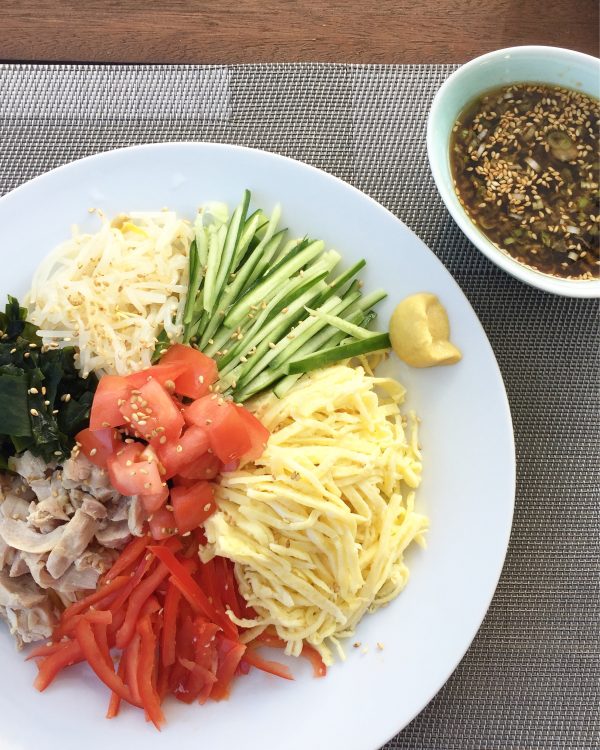| Servings |
|
- Amazu Dare yields about 2 cups
- 180 cups ml. or 6 fl. oz. kombu dashi (to make soak a 4-inch piece of kombu (dried kelp) in 2room-temperature water for an hour, then remove and discard kombu)
- 180 ml or 6 fl. oz. soy sauce
- 200-220 ml. or about 7 fl. oz. rice vinegar
- 6 tbsp. sugar
- 100 ml. or 3.5 fl. oz. mirin
- 1 tbsp. sesame oil
- 2 tbsp. juice from grated fresh ginger optional
- 2 tbsp. fresh lemon juice
- Noodles and toppings
- 12-16 oz. ramen noodles (preferably uncooked noodles availablethe freezer section at Asian groceries)
- 6-8 oz. chicken breast fillets chicken tenders, store-bought cooked cha-shu pork, or cooked ham
- 1 oz ginger root if using chicken
- 1 bunch green onions about 3" of green part only (if using chicken)
- 2 Persian or 1/3 English cucumber halved lengthwise and thinly julienned
- 2 medium tomatoes each cut into 8 wedges
- Note: You can also add other vegetables such as wakame seaweed blanched bean sprouts, shredded lettuce, or cooked shiitake mushrooms.
- 4 eggs
- a pinch of salt
- 1/2 tsp. potato starch mixed with 1/2 tsp. water
- 2 tbsp. powdered Japanese mustard mixed with 2 tbsp. water or 2 tbsp. prepared mustard paste
Ingredients
|
- For amazu dare, combine all ingredients except ginger and lemon juice in a medium saucepan. Bring to a boil and cook for 1 minute. Turn off heat, add ginger and lemon juice, and transfer tare to a container. Allow it to cool to room temperature, then chill in fridge. The tare will keep for up to a month in the fridge, so you should have enough to make Hiyashi Chuka several times.
- For Kinshi tamago (shredded egg crepe), beat eggs and add a pinch of salt and the potato starch mixture. Mix well. Heat a 9-inch non-stick or greased stainless steel pan over medium heat. Pour one quarter of the egg batter into the pan, spreading the batter evenly to cover the entire bottom of the pan. Cook for about 30 seconds, or until the surface is no longer wet and the edges are starting release from the pan edges. Pick up the edge of the crepe and flip it. Cook for about 10 to 15 seconds, transfer the crepe to a cutting board, and cool to room temperature. Cut the crepe into quarters, stack the pieces into a pile, then slice them thinly. Put aside.
- If you are using chicken breast for the meat topping, place chicken in a deep pot and add enough water to cover by one inch, along with ginger root and green onion. Bring to a boil, reduce heat to medium-high, and cook for one minute. Cover pot and turn off the heat. Leave the lid on for about 30 minutes; chicken will continue to cook with residual heat. Cut into chicken to make sure it is no longer pink inside. Tear cooked chicken into shreds. If you are using cha-shu pork or cooked ham, slice into matchstick-sized pieces about 2 inches long. Put aside.
- For noodles, boil 7-8 cups of water in a deep pot. Follow the cooking instructions on the package. Cooking time is usually 1-3 minutes. Drain noodles and give them a quick rinse under cold running water.
- Divide the cooked noodles into four portions and put each serving in a shallow bowl or on a plate. Garnish with Kinshi tamago, cucumber, meat, and tomatoes, and put a teaspoon of mustard on the edge of the bowl or plate. Pour 4 oz of amazu dare around the noodles and mix tare and mustard if you like as you toss the toppings and noodles together. Enjoy the authentic Hiyashi Chuka experience!

